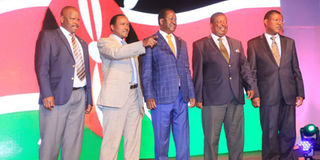Nasa's manifesto more detailed than Cord's

From left: Nasa co-principals Isaac Ruto, Kalonzo Musyoka, Raila Odinga, Musalia Mudavadi and Moses Wetang'ula at the launch of the coalition's manifesto at Ngong Racecourse in Nairobi on June 27, 2017. FILE PHOTO | JEFF ANGOTE | NATION MEDIA GROUP
What you need to know:
The declaration differs both in content and details of how Raila Odinga and Kalonzo Musyoka plan to organise the government should they be elected into office.
Cord's manifesto was a straightforward, 10-point blueprint that focused on job creation, food security, social equality, poverty reduction, quality education, healthcare and infrastructure and land.
The manifesto the National Super Alliance unveiled on Tuesday differs substantially from that of the Coalition for Reforms and Democracy from four years ago and is more detailed than it.
The declaration differs both in content and details of how presidential candidate Raila Odinga and his running mate Kalonzo Musyoka plan to organise the government should they be elected into office.
Cord's manifesto was a straightforward, 10-point blueprint that focused on job creation, food security, social equality, poverty reduction, quality education, healthcare and infrastructure and land.
At the time, Mr Odinga of was also a presidential candidate and Mr Musyoka his running mate.
The document launched on Tuesday has many variations – it is anchored on six pillars with focus on culture, sports, language, peace and security that were not part of focus in 2013.
The pillars are nation building, the State building, transforming governance, realising social and economic rights, creating jobs and eradicating poverty and regional and international cooperation.
Under the nation building pillar, Nasa promises to build a stronger nation committed to nurturing and protecting the wellbeing of the individual, the family, communities and the nation.
They hope to achieve this by developing a national identity, inculcation of national values, inclusion of all communities, unleashing the power of culture, language policy, transforming sports, coming to terms with the past and peace and security.
Recognising Kenya as a sports global super power particularly in long-distance running, Nasa says this success story has become part of our positive global identity.
“Nothing unites us as Kenyans as watching our athletes win. Young Kenyans have shown great potential in other sports in the past including football, cricket, boxing, swimming, rugby and hockey. Unfortunately, this success and potential is not anchored on government policies or adequate support,” the manifesto reads in part.
It says the negative role in the management of sports and high level corruption have reached shameful levels under the Jubilee administration.
'DOPING SCANDALS'
“Corruption, mismanagement and even doping scandals have begun to taint our good name and jeopardises the future of our sports and success of our youth,” it says.
Nasa promises it will work with stakeholders to transform and strengthen the legal and institutional arrangements of sporting infrastructure.
Nasa argues that nationhood must be anchored on peace and security for all and promises to work with Kenyans to make Kenya a haven of peace.
“We will build a nation where Kenyans are at peace with themselves, are at peace with the land and at peace with their neighbours,” it says.
Nasa promises to develop a National Peace and Security framework with the capacity to address causes of conflict and violence, including structural ones, that affect Kenya.
'IMPORTANT PILLAR'
“Peace-building with communities and between communities will be an important pillar in the framework. We shall develop joint efforts and a shared responsibility between the national and county levels of government,” the document states.
They also promise to develop a national plan to address regional security challenges through a consultative process, address peace and security challenges that have bedevilled certain regions from colonial times including northern region, parts of eastern, parts of coast and parts of Rift Valley.
The regional plans will include making genuine peace amongst all communities and developing investment interventions designed to spur inclusive economic growth, creation of employment and enhance livelihoods.
They will also implement infrastructure development designed to enhance ease of travel, improve communication and abolish a sense of remoteness and alienation and provide adequate security services to all Kenyans.





